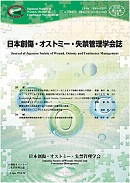Volume 23, Issue 4
Displaying 1-13 of 13 articles from this issue
- |<
- <
- 1
- >
- >|
Lecture
-
Article type: Lecture
2020Volume 23Issue 4 Pages 365-369
Published: 2020
Released on J-STAGE: March 04, 2020
Download PDF (1506K)
Lecture
-
Article type: Lecture
2020Volume 23Issue 4 Pages 370-377
Published: 2020
Released on J-STAGE: March 04, 2020
Download PDF (883K)
Special Program
-
Article type: Special Program
2020Volume 23Issue 4 Pages 378-382
Published: 2020
Released on J-STAGE: March 04, 2020
Download PDF (1481K) -
Article type: Special Program
2020Volume 23Issue 4 Pages 383-389
Published: 2020
Released on J-STAGE: March 04, 2020
Download PDF (2427K) -
Article type: Special Program
2020Volume 23Issue 4 Pages 390-393
Published: 2020
Released on J-STAGE: March 04, 2020
Download PDF (1077K) -
Article type: Special Program
2020Volume 23Issue 4 Pages 394-405
Published: 2020
Released on J-STAGE: March 04, 2020
Download PDF (5145K)
Symposium
-
Article type: Symposium
2020Volume 23Issue 4 Pages 406-411
Published: 2020
Released on J-STAGE: March 04, 2020
Download PDF (973K)
Symposium
-
Article type: Symposium
2020Volume 23Issue 4 Pages 412-417
Published: 2020
Released on J-STAGE: March 04, 2020
Download PDF (863K)
Symposium
-
Article type: Symposium
2020Volume 23Issue 4 Pages 418-425
Published: 2020
Released on J-STAGE: March 04, 2020
Download PDF (1009K)
Original Article
-
Article type: Original Article
2020Volume 23Issue 4 Pages 426-436
Published: 2020
Released on J-STAGE: March 04, 2020
Download PDF (935K)
Report
-
Article type: Report
2020Volume 23Issue 4 Pages 437-441
Published: 2020
Released on J-STAGE: March 04, 2020
Download PDF (680K) -
Article type: Report
2020Volume 23Issue 4 Pages 442-448
Published: 2020
Released on J-STAGE: March 04, 2020
Download PDF (1302K)
-
2020Volume 23Issue 4 Article ID: 0
Published: 2020
Released on J-STAGE: March 05, 2020
Download PDF (70K)
- |<
- <
- 1
- >
- >|
